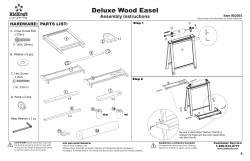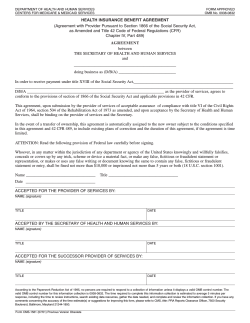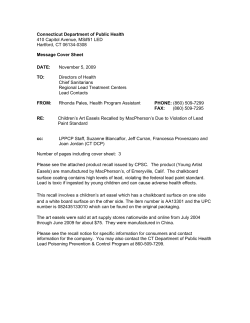
U.S. Consumer Product Safety yy Commission
U.S. Consumer Product Safetyy Commission Manufacturers of Doll Clothing for Children’s Dolls: A li bl CPSC Child Applicable Children’s ’ P Product d Safetyy Rules Presentation for certain members of the Handmade Toy Alliance and other interested manufacturers, April 5, 2012 Neal S. Cohen, Small Business Ombudsman Views expressed in this presentation are those of the staff and do not necessarily represent the views of the Commission. Today’ss Agenda Today Update on Consumer Product Safety Improvement Act (CPSIA) of 2008 and Public La 112Law 112-28 (August (A g st 12, 12 2011) Overview of Requirements Generally Applicable for Doll Clothing for Children’s Dolls Tracking c g Labels, be s, Third d Partyy Testing, es g, Children’s Product Certificates, and Component Part Testing. Testing (See Archived Webcast) Introduction to Small Batch Manufacturer R i Registration i with i h the h CPSC (S (See A Archived hi d Webcast) 2 Jurisdiction Children Children’s s dolls and clothes intended to dress children’s dolls are a consumer product d t regulated l t db by th the CPSC. CPSC Co Considered s de ed a “Toy” oy a and d a “Children’s C de s Product” under the Consumer Product Safety Improvement Act (CPSIA) of 2008 2008. 3 Consumer Product Safety Improvement Act (CPSIA) of 2008 4 Consumer Product Safety Improvement Act (CPSIA) of 2008 “Children’s Children s products products” are designed or intended primarily for children 12 years old and younger. Key substantive requirements for children’s products:: products p 1. 2 2. 3. 4. Lead content in accessible components (100 ppm) ppm) Lead in paint and surface coatings (0.009%, (0 009% 90 ppm ppm)) Phthalates (0.1% per banned phthalate) – Accessible components off toys andd certain i child hild care articles i l (related to sleeping & feeding) Toy Safety Standard (ASTM F963F963-08) (ASTM F963F963-11, 5 effective 6/12/12) Key process requirements for children’s products primarily intended for children 12 years old and younger: Third Thi d party testing i by b CPSCCPSC-acceptedd labs l b ( Registered small batch manufacturers are not required to 3PT for certain rules) Conformity certificates issued by importers & manufacturers (Children (Children’ss Product Certificate) Tracking label New safety rules for durable infant products: Cribs; C bs; infant a t walkers; wa e s; bath bat seats; toddler todd e beds; play p ay yards; bed rails; additional items every six months Product registration cards www.SaferProducts.gov – Publicly Searchable Database6 Child ’ P Children’s Product d S Safety f Rules Generally Applicable to Doll Clothing for Children’s Dolls www cpsc gov www.cpsc.gov 7 Safety Rules for Doll Clothing for Child ’ D Children’s Dolls ll 1 1. Total lead content in all accessible component materials (substrate) shall not exceed 100 parts per million (ppm (ppm). ). 2 2. Total lead content in all lead in paint and other surface coatings shall not exceed 0.009 percent (90 ppm ppm). ). 3. CPSIA Sec. 101 16 CFR P Partt 1303 Ban on small parts for products intended for children under d 3 years off age. 16 CFR Part 1501 8 Safety Rules for Doll Clothing for Children’s Dolls (cont’d) 4. F963--08 (F963 (-11) Toy Safety Standard 5. Ban on Certain Phthalates in accessible component parts of toys p y and certain child care articles (related ( to sleeping & feeding) 6. CPSIA Sec. 106 CPSIA Sec. 108 Flammability * – Prohibition on a Children’s Toy as a Flammable or an Extremely Flammable Solid Federal Hazardous Substances Act (FHSA) *Third party testing not required 9 Total Lead Content Limits All Children’s Products 100 Parts Per Million www cpsc gov/lead www.cpsc.gov/lead 10 Total Lead Content Limit is 100 parts per million. Applies to accessible component parts only 16 CFR § 1500.87 Very useful list of exemptions found at 16 CFR § 1500.91 1500 91 (Textiles, (Textiles wood, wood paper, paper plant plant-- and animalanimalderived materials) Third party lab testing not required to verify above list MOST textiles used in doll clothing are covered (cotton wool, (cotton, wool bamboo, bamboo hemp hemp, also polyester (fleece), (fleece) spandex, elastic, rubber. Check 16 CFR § 1500.91 for full list list. 11 Total Lead Content Textiles exemption includes dyed and undyed textiles. M t i l only Materials l exempted t d if unadulterated d lt t d andd untreated. t t d Exemption does not apply if materials are screen printed or tr t d with treated ith water t r orr stainstain t in-resistant r i t nt substances, bt n allll off which hi h may contain lead in PVC or other materials. Exemption for leather does not apply to painted leather leather. Velcro and Aplix are exempted fabrics. IMPORTANT: IMPORTANT P TA T: Snaps, S buttons, b and d other h ffasteners (metal, poly poly--resin) all must comply (and be third party tested*) d*) with i h the h lilimit i on totall llead d content. Dolls: Plastic doll heads are an area of concern. (*Registered small batch manufacturer need not third party test. Products must still comply.) 12 Limits on Lead in Paint and Surface Coatings All Children’s Children s Products 90 Parts Per Million 13 Lead in Paint and Surface Coatings Concentration level of 0.009% (90 parts per million) in paint and surface coatings No exceptions Can thee material Ca a e a be sc scraped aped off? o ? If so, CPSC C SC staff sa would treat it as a surface coating. Otherwise, it is part of the substrate and tested (different methods) to the total lead content limit of 100 parts per million. 14 Lead in Paint and Surface Coatings Ordinary screen printing is usually considered part of the substrate under the total lead content requirement and should be tested accordingly. accordingly (If, however, the screen printing can be scraped off, it is treated g y See FAQ Q for more as a surface coatingg and tested accordingly. information.) Manyy printed p garments g (roller ( printing, p g, fabric store bolts) where the ink is absorbed and acts like a dye may be exempt p from total lead content testing. g 16 CFR § 1500.91 15 Lead in Paint and Surface Coatings For doll clothing, zippers, buttons, or other components may bear paint or another surface coating coating. Some zippers bear paint and are scrapable scrapable,, whereas others are made of polyresin polyresin,, bakedbaked-on enameled paints, paints or bear electroplating that are likely considered substrate materials. 16 Ban on Small Parts Products Intended for Children under 3 Years of Age 16 CFR Part 1501 17 Ban on Small Parts Products Intended for Children under 3 Years of Age 16 CFR Part 1501 Anyy object j that fits completely p y into a specially p y designed g test cylinder 2.25 inches long by 1.25 inches wide that approximates pp the size of the fullyy expanded p throat of a child under 3 years old. Products for children between 3 years and under 6 years of age must be labeled with warning if product has small parts “as as received. received ” Products for children under 3 years of age must be s bjected to “use subjected “ se and abuse ab se testing.” testing ” 18 Ban on Small Parts Products Intended for Children under 3 Years of Age Products for children under 3 years of age must be subjected to “use and abuse testing.” Testing uses different forces for different age groups: 00-18, 18--36 months. 18 If small parts do not separate after “use and abuse g then the product p does not violate the ban. testing,” If small parts do separate after “use and abuse testing,” then the product violates the ban. CPSC staff completes a risk assessment to guide its response to any violations violations. 19 Toy Safety Standard ASTM F963F963-08 ASTM F963F963-11 (June 12, 2012) CPSIA Sec. 106 20 Toyy Safetyy Standard • F963-08 has ((ii) Substantive Requirements and F963p id / p d (ii) Testing provides/expands T ti Methods M th d for f longstanding regulations, like small parts. Use and Abuse – Drop It: • Use and Abuse – Pull It: • Tension Test Section, Sections 8.8 Use and Abuse – Twist It: Use and Abuse Testing 16 CFR § § 1500.50, .51, .52, .53; F963--11 Sections 4.6, 8.6, 8.7 F963 Torque Test Sections, Section 8.9 Illustrative Only; Additional Sections May Apply. See F963 Table of Contents. 21 Ban on Certain Phthalates CPSIA Sec. 108 22 Permanent Ban on Phthalates Section 108 of the CPSIA Congress has permanently banned three phthalates (DEHP, DBP, BBP) in any amount greater than 0.1 percent (computed for each phthalate, phthalate individually) in accessible component parts of (1) children's toys and (2) certain child care articles. A "children's children s toy toy" is defined as a consumer product designed or intended by the manufacturer for a child who is 12 years old or younger for use by the child when the child plays. "Child care articles" are defined as consumer products that are designed or intended by the manufacturer for a child who is 3 years old or younger, to facilitate sleeping or feeding, or to help a child who is sucking or teething. 23 Interim Ban on Phthalates Section 108 of the CPSIA Congress has also banned (on an interim basis) three additional phthalates (DINP, DIDP, DnOP) DnOP) in any amount greater than 0 1 percent (computed for each phthalate individually) in 0.1 accessible component parts of (1) a children's toy that can be placed in a child's mouth, p mouth, and (2) ( ) child care articles. A toy that can be placed in a child's mouth is defined as any part of a toy that actually can be brought to the child's mouth and kept there so that it can be sucked or chewed on. If a toy or a part of the toy is smaller than 5 centimeters, it can be placed in the h mouth. h 24 Bans on Phthalates Section 108 of the CPSIA The ban does not apply to component parts that are inaccessible to a child. Applies only to plasticized component parts (or other product p p parts that could conceivably contain phthalates) of children's toys and child care articles and only those parts of the product should be third party tested for phthalates. It is not necessaryy to test and certifyy materials that are known not to contain phthalates or to certify that phthalates are absent from materials that are known not p to contain phthalates. 25 Ban on Certain Phthalates Doll clothing: Soft, plasticized buttons, toggles, inks, paints, vinyl (raincoats), etc. all must comply (and be third party tested*) with the ban on certain phthalates. Dolls: Soft plastic doll heads are a concern. Source carefully. y Seek Children’s Product Certificate/testing records/assurances before you purchase component p p materials. ((*Registered g small batch manufacturer need not third party p y test. Products must still comply.) 26 Flammability – Prohibition on a Children’s Toy as a Flammable or an Extremely E tremel Flammable Solid 27 Flammability Requirements A child’s toy cannot be a flammable or an extremely flammable solid, as defined in the Federal Hazardous Substances Act (FHSA.) Testing is not required to show compliance. See FHSA Regulatory g Summary. Section 4.2 of ASTM F963 and Annex 4 are not part of the mandatory toy safety standard. Fire--retardant chemicals are not required. Fire Various ways to ensure safe toys that are not “flammable” flammable or “extremely extremely flammable flammable,” under the FHSA. 28 Flammability Requirements S Source Carefully: C f ll Use materials known to comply with 16 CFR Parts 1610, W i A Wearing Apparel/Clothing l/Cl thi T Textiles til Flammability Fl bilit Standard St d d . May rely on exemptions already codified at 16 CFR 1610.1(d) in the wearing apparel flammability standard. standard 29 May Rely on Existing Exemption Products made entirely from one or more of these fabrics are exempt from any requirement that they be tested for compliance with the Wearing Apparel/Clothing Textiles Flammability Standard : (1) Plain surface s rface fabrics, fabrics regardless of fiber content, content weighing eighing 2.6 ounces per square yard or more; and (2) All fabrics, fabrics both plain surface and raised raised--fiber surface textiles, regardless of weight, made entirely from any of the followingg fibers or entirelyy from a combination of the following fibers: acrylic, modacrylic modacrylic,, nylon, olefin, polyester, wool. 30 Flammability Requirements S Source Carefully: C f ll Use materials known to comply with 16 CFR Parts 1610, W i A Wearing Apparel/Clothing l/Cl thi T Textiles til Flammability Fl bilit Standard. St d d See 16 CFR § 1610.1(d) for exempted material list. Purchase from a supplier who provides you with a General Certificate of Conformity (GCC); Purchase from a supplier with a “guaranty” guaranty of flammability on file with the CPSC; http://www.cpsc.gov/businfo/ffa.html Many bolt fabrics at retail fabric stores will have flammability compliance information on bolt ends. Document it for your records. 31 Flammability – Extremely Flammable Solid Various Tests Available to Show Compliance*: 16 CFR Parts 1610 and/or 1611, as applicable 16 CFR § 1500.44 Annex A6 of ASTM F963F963-11 (*Third party testing not required.) 32 Vi l Pl Vinyl Plastic i Fil Films Vinyl is not an exempted fabric. (E.g., doll raincoats). Same for polyurethane laminate (PUL). Technically a “film” covered by 16 CFR Part 1611 May be tested as part of a garment per 16 CFR Part 1610 Typically, use the “composite composite testing testing” procedures as per 16 CFR 1610.33 See the procedures in the Children’s Sleepwear Test Manual (p. 25) Small batch manufacturers may be able to rely on their supplier’s written assurances. 33 SMALL BATCH MAN FACT R RS MANUFACTURERS Public Law 112 112--28 (August 12, 2011) www cpsc gov/smallbatch www.cpsc.gov/smallbatch 34 Small Batch Manufacturer Registration Request: g SaferProducts.gov 35 Registered Small Batch Manufacturer 1. Total lead content in all accessible substrate materials shall not exceed 100 parts per million ((ppm ppm). ). 2. Total lead content in all accessible b lead in p paint and other surface coatings shall not exceed 90 ppm ppm.. 3. CPSIA Sec. 101 16 CFR Part 1303 Ban on small parts for products intended for children under 3 years of age 16 CFR Part 1501 36 Registered Small Batch Manufacturer 4. F963--08 ((--11) Toy Safety Standard F963 5. Ban on Certain Phthalates Requirement 6. Flammability * – Prohibition on a Dangerously Flammable Solid *Third party testing not required 37 Additional Requirements Third Party Testing Component Part Testing Children Children’ss Product Certificates www.cpsc.gov/3PT under “Resources” T ki Labels Tracking L b l www.cpsc.gov/3PT; p g www.cpsc.gov/labsearch p g www.cpsc.gov/trackinglabel Beginning February 2013….Periodic Testing www.cpsc.gov/3PT 38 Additional Requirements Sec. 15 & Sec. 37 Reporting Requirements Registration g with SaferProducts.gov g (the ( publicly p y searchable database) is recommended. 39 Resources Small Business Information www.cpsc.gov/sbo Addi i l IIndustry Additional d G id Guidance Regulatory g summaries, testingg manuals (flammability), CPSC Recall Handbook, and more... http://www.cpsc.gov/businfo/corrective.html p //www p g / / 40 For More Information: Neal S. Cohen Small Business Ombudsman Office of Education, Global Outreach, and Small Business Ombudsman ncohen@cpsc.gov ncohen@cpsc gov www.cpsc.gov/sbo twitter.com/cpscsmallbiz twitter.com/ cpscsmallbiz 301--504301 504-7504 www.cpsc.gov www.SaferProducts.gov 41
© Copyright 2025
















